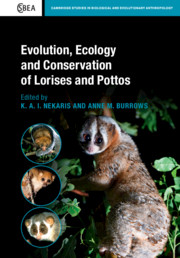Book contents
- Evolution, Ecology and Conservation of Lorises and Pottos
- Cambridge Studies in Biological and Evolutionary Anthropology
- Evolution, Ecology and Conservation of Lorises and Pottos
- Copyright page
- Dedication
- Contents
- Contributors
- Foreword
- Acknowledgements
- 1 Introduction
- Part I Evolution, Morphology and the Fossil Record
- Part II Ecology and Captive Management
- Part III Research, Trade and Conservation
- 24 Trapping, Collaring and Monitoring the Lorisinae of Asia (Loris, Nycticebus) and Perodicticinae (Arctocebus, Perodicticus) of Africa
- 25 Evaluation of Field Techniques Used to Assess Populations of Pottos and Lorises
- 26 Occupancy Modelling as a Method to Study Slender Loris Density
- 27 Using Accelerometers to Measure Nocturnal Primate Behaviour
- 28 Distribution and Conservation Status of Slow Lorises in Indo-China
- 29 Wildlife Trade Research Methods
- 30 Online Imagery and Loris Conservation
- 31 Slow Lorises (Nycticebus spp.) as Photo Props on Instagram
- 32 Integrating Science and Puppetry to Inspire Teenagers in Rural Asia to Value Slow Lorises
- 33 Developing a Rescue and Rehabilitation Centre as a Reaction to the Extensive Illegal Wildlife Trade in Slow Lorises
- References
- Index
28 - Distribution and Conservation Status of Slow Lorises in Indo-China
from Part III - Research, Trade and Conservation
Published online by Cambridge University Press: 29 February 2020
- Evolution, Ecology and Conservation of Lorises and Pottos
- Cambridge Studies in Biological and Evolutionary Anthropology
- Evolution, Ecology and Conservation of Lorises and Pottos
- Copyright page
- Dedication
- Contents
- Contributors
- Foreword
- Acknowledgements
- 1 Introduction
- Part I Evolution, Morphology and the Fossil Record
- Part II Ecology and Captive Management
- Part III Research, Trade and Conservation
- 24 Trapping, Collaring and Monitoring the Lorisinae of Asia (Loris, Nycticebus) and Perodicticinae (Arctocebus, Perodicticus) of Africa
- 25 Evaluation of Field Techniques Used to Assess Populations of Pottos and Lorises
- 26 Occupancy Modelling as a Method to Study Slender Loris Density
- 27 Using Accelerometers to Measure Nocturnal Primate Behaviour
- 28 Distribution and Conservation Status of Slow Lorises in Indo-China
- 29 Wildlife Trade Research Methods
- 30 Online Imagery and Loris Conservation
- 31 Slow Lorises (Nycticebus spp.) as Photo Props on Instagram
- 32 Integrating Science and Puppetry to Inspire Teenagers in Rural Asia to Value Slow Lorises
- 33 Developing a Rescue and Rehabilitation Centre as a Reaction to the Extensive Illegal Wildlife Trade in Slow Lorises
- References
- Index
Summary
China is the second-most primate-diverse country in Asia and is home to 3 families, 8 genera and 29 species of primates (Jiang et al., 2017). As the group of nocturnal strepsirrhine primates, two species of Lorisidae, Nycticebus bengalensis and N. pygmaeus, are generally reported in China (Brandon-Jones et al., 2004; Ji and Jiang, 2004; Jiang et al., 2017; Roos et al., 2014). Dao Van Tien (1960) proposed an intermediate species (N. intermedius) in Vietnam based on pelage characteristics and morphology, and it was listed as an independent species distributed sympatrically with N. pygmaeus in China by some researchers (Sheng et al., 1999; Zhang et al., 2002). A series of morphological and molecular genetic studies (Groves, 2001; Ratajszczak, 1998; Wang et al., 1996; Zhang et al., 1993) did not support the existence of this new loris species, and therefore N. pygmaeus is considered a distinct species with no subspecies and N. intermedius is considered a junior synonym for the species.
- Type
- Chapter
- Information
- Evolution, Ecology and Conservation of Lorises and Pottos , pp. 326 - 338Publisher: Cambridge University PressPrint publication year: 2020
- 3
- Cited by



